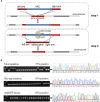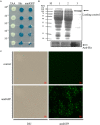A Novel and Efficient Method for Bacteria Genome Editing Employing both CRISPR/Cas9 and an Antibiotic Resistance Cassette
- PMID: 28529507
- PMCID: PMC5418352
- DOI: 10.3389/fmicb.2017.00812
A Novel and Efficient Method for Bacteria Genome Editing Employing both CRISPR/Cas9 and an Antibiotic Resistance Cassette
Abstract
As Cas9-mediated cleavage requires both protospacer and protospacer adjacent motif (PAM) sequences, it is impossible to employ the CRISPR/Cas9 system to directly edit genomic sites without available PAM sequences nearby. Here, we optimized the CRISPR/Cas9 system and developed an innovative two-step strategy for efficient genome editing of any sites, which did not rely on the availability of PAM sequences. An antibiotic resistance cassette was employed as both a positive and a negative selection marker. By integrating the optimized two-plasmid CRISPR/Cas system and donor DNA, we achieved gene insertion and point mutation with high efficiency in Escherichia coli, and importantly, obtained clean mutants with no other unwanted mutations. Moreover, genome editing of essential genes was successfully achieved using this approach with a few modifications. Therefore, our newly developed method is PAM-independent and can be used to edit any genomic loci, and we hope this method can also be used for efficient genome editing in other organisms.
Keywords: CRISPR/Cas9; antibiotic resistance cassette; genome editing; protospacer adjacent motif; sequence-independent.
Figures





Similar articles
-
SpRY Cas9 Can Utilize a Variety of Protospacer Adjacent Motif Site Sequences To Edit the Candida albicans Genome.mSphere. 2021 May 19;6(3):e00303-21. doi: 10.1128/mSphere.00303-21. mSphere. 2021. PMID: 34011687 Free PMC article.
-
[Cas9 protein variant VQR recognizes NGAC protospacer adjacent motif in rice].Yi Chuan. 2018 Dec 20;40(12):1112-1119. doi: 10.16288/j.yczz.18-126. Yi Chuan. 2018. PMID: 30559100 Chinese.
-
Efficient SSA-mediated precise genome editing using CRISPR/Cas9.FEBS J. 2018 Sep;285(18):3362-3375. doi: 10.1111/febs.14626. Epub 2018 Aug 25. FEBS J. 2018. PMID: 30085411
-
Factors affecting the cleavage efficiency of the CRISPR-Cas9 system.Anim Cells Syst (Seoul). 2024 Mar 3;28(1):75-83. doi: 10.1080/19768354.2024.2322054. eCollection 2024. Anim Cells Syst (Seoul). 2024. PMID: 38440123 Free PMC article. Review.
-
Recent Advances in Genome Editing Using CRISPR/Cas9.Front Plant Sci. 2016 May 24;7:703. doi: 10.3389/fpls.2016.00703. eCollection 2016. Front Plant Sci. 2016. PMID: 27252719 Free PMC article. Review.
Cited by
-
Applications of CRISPR/Cas13-Based RNA Editing in Plants.Cells. 2022 Aug 27;11(17):2665. doi: 10.3390/cells11172665. Cells. 2022. PMID: 36078073 Free PMC article. Review.
-
Development of an Efficient Genome Editing Tool in Bacillus licheniformis Using CRISPR-Cas9 Nickase.Appl Environ Microbiol. 2018 Mar 1;84(6):e02608-17. doi: 10.1128/AEM.02608-17. Print 2018 Mar 15. Appl Environ Microbiol. 2018. PMID: 29330178 Free PMC article.
-
Editing the microbiome the CRISPR way.Philos Trans R Soc Lond B Biol Sci. 2019 May 13;374(1772):20180103. doi: 10.1098/rstb.2018.0103. Philos Trans R Soc Lond B Biol Sci. 2019. PMID: 30905295 Free PMC article. Review.
-
Efficient dual-negative selection for bacterial genome editing.BMC Microbiol. 2020 May 24;20(1):129. doi: 10.1186/s12866-020-01819-2. BMC Microbiol. 2020. PMID: 32448155 Free PMC article.
-
Role of CRISPR-Cas systems and anti-CRISPR proteins in bacterial antibiotic resistance.Heliyon. 2024 Jul 16;10(14):e34692. doi: 10.1016/j.heliyon.2024.e34692. eCollection 2024 Jul 30. Heliyon. 2024. PMID: 39149034 Free PMC article. Review.
References
-
- Bolotin A., Quinquis B., Sorokin A., Ehrlich S. D. (2005). Clustered regularly interspaced short palindrome repeats (CRISPRs) have spacers of extrachromosomal origin. Microbiology 151(Pt 8) 2551. - PubMed
LinkOut - more resources
Full Text Sources
Other Literature Sources
Research Materials
Miscellaneous

